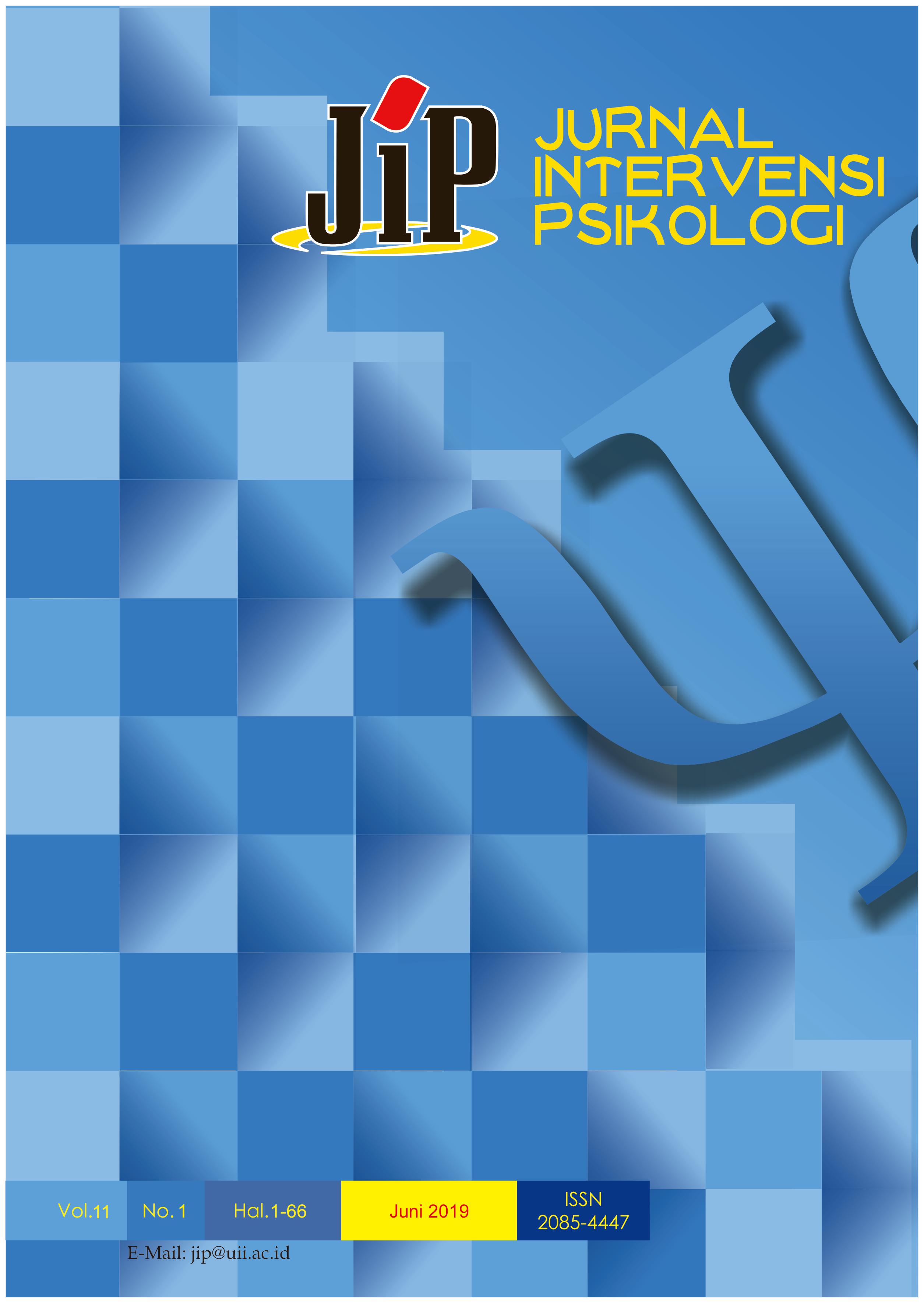Main Article Content
Abstract
This study aims to determine the effectiveness of gratitude exercise using three good things techniques on happiness at work enhancement. Participants of this study were 15 employees aged 21-28 years divided into two groups: eight participants in the experimental group and seven participants in the control group. The design was a randomized two-group pretest-posttest. Collecting data used to happiness at work scale with Likert model prepared by the researcher. Data analysis methods used by using Mann Whitney U technique for differences of the gain score in the experimental group and control group data score. The result of gain score analysis showed t value = 8.500 and p-value of 0.021 (p<0.05), indicating there is a significant difference between the experimental group and control group after gratitude exercise. The result shows that gratitude exercise using three good things techniques is effective to increase happiness at work of employees.
Key notes: gratitude exercise, happiness at work, three good things
Keywords
Article Details
Copyright (c) 2020 Authors

This work is licensed under a Creative Commons Attribution-ShareAlike 4.0 International License.
Authors who publish with this journal agree to the following terms:
- Authors retain copyright and grant the journal right of first publication with the work simultaneously licensed under a Creative Commons Attribution-ShareAlike 4.0 International License that allows others to share the work with an acknowledgment of the work's authorship and initial publication in this journal.
- Authors are able to enter into separate, additional contractual arrangements for the non-exclusive distribution of the journal's published version of the work (e.g., post it to an institutional repository or publish it in a book), with an acknowledgment of its initial publication in this journal.
- Authors are permitted and encouraged to post their work online (e.g., in institutional repositories or on their website) prior to and during the submission process, as it can lead to productive exchanges, as well as earlier and greater citation of published work (See The Effect of Open Access).
References
- Albrecht, S. L. (2010). Handbook of employee engagement: Perspective, issues, research and practice. UK: Edward Elgar Publishing Limited.
- Chancellor, J., Layous, K., & Lyubomirsky, S. (2015). Recalling positive events at work makes employees feel happier, move more, but interact less: A 6-week randomized controlled intervention at a Japanese workplace. Journal of Happiness Studies, 16(4), 871–887. https://doi.org/10.1007/s10902-014-9538-z
- Csikszentmihalyi, M. (2008). Flow: The psychology of optimal experience. New York: Harper Perennial Modern Classics.
- Dewanto, W., & Retnowati, S. (2015). Intervensi kebersyukuran dan kesejahteraan penyandang disabilitas fisik. E-Jurnal Gama JPP, 1(1), 33–47.
- Emmons, R. A. (2007). Thanks; How the new science of gratitude can make you happier. Boston: Houghton Miflin Company.
- Fisher, C. D. (2010). Happiness at work. International Journal of Management Reviews, 12(4), 384–412. https://doi.org/10.1111/j.1468-2370.2009.00270.x
- Froh, J. J., Yurkewicz, C., & Kashdan, T. B. (2009). Gratitude and subjective well-being in early adolescence: Examining gender differences. Journal of Adolescence, 32(3), 633–650. https://doi.org/10.1016/j.adolescence.2008.06.006
- Kaplan, S., Bradley-Geist, J. C., Ahmad, A., Anderson, A., Hargrove, A. K., & Lindsey, A. (2014). A test of two positive psychology interventions to increase employee well-being. Journal of Business andPsychology, 29(3), 367–380. https://doi.org/10.1007/ s10869-013-9319-4
- Khoiri, A. (2016). 33 persen pekerja Indonesia tidak bahagia. Diakses pada 8 November 2018 dari https://www.cnnindonesia.com/gaya-hidup/20160722101825-277-146292/33-persen-pekerja-indonesia-tidak-bahagia?
- McCullough, M. E., Emmons, R. A., & Tsang, J. A. (2002). The grateful disposition: A conceptual and empirical topography. Journal of Personality and Social Psychology, 82(1), 112–127. https://doi.org/10.1037/0022-3514.82.1.112
- Miller, L., Bansal, R., Wickramaratne, P., Hao, X., Tenke, C. E., Weissman, M. M., & Peterson, B. S. (2014). Neuroanatomical correlates of religiosity and spirituality a study in adults at high and low familial risk for depression. JAMA Psychiatry, 71(2),128–135. https://doi.org/10.1001/ jamapsychiatry.2013.3067
- Mitchell, J., Vella-Brodrick, D., & Klein, B. (2010). Positive psychology and the internet: A mental health opportunity. E-Journal of Applied Psychology, 6(2), 30–41. https://doi.org/10.7790/ ejap.v6i2.230
- Mukhlis, H. (2016). Pelatihan kebersyukuran; Sebuah upaya untuk menurunkan kecemasan menghadapi ujian nasional pada siswa SMA. Jurnal Aisyah : Jurnal Ilmu Kesehatan, 1(1), 09–18. https://doi.org/10.30604/ jika.v1i1.3
- Myers, A., & Hansen, C. (2012). Experimental Psychology. USA: Wadsworth.Passmore, J., & Oades, L. (2016). Positive psychology techniques; three good things. The Coaching Psychologist, 12(2).
- Pryce-Jones, J. (2010). Happiness at work: Maximizing your psychological capital for success. Chichester: Wiley-Blackwell.
- Pryce-Jones, J., & Lindsay, J. (2014). What happiness at work is and how to use it. Industrial and Commercial Training, 46(3), 130–134. https://doi.org/ 10.1108/ICT-10-2013-0072
- Rodríguez-Muñoz, A., & Sanz-Vergel, A. I. (2013). Happiness and well-being at work: A special issue introduction. Revista de Psicologia Del Trabajo y de Las Organizaciones, 29(3), 95–97. https://doi.org/10.5093/tr2013a14
- Sarwono, J. (2018). Statistik untuk riset skripsi. Yogyakarta: Penerbit Andi.
- Seligman, M. E. P., Steen, T. A., Park, N., & Peterson, C. (2005). Positive psychology progress: empirical validation of interventions. The American Psychologist, 60(5), 410–421. https://doi.org/10.1037/0003-066X.60.5.410
- Sexton, B. (2014). Clinical trials conducted at Duke University with three cohorts: neonatal ICU, internal medicine residents and patien safety leadership. https://www.midmichigan.org/about
- Silton, N. R. (2018). Scientific Concepts Behind Happiness, Kindness and Empathy in Contemporary Society. USA: IGI Global;1 edition.
- Sin, N. L., & Lyubomirsky, S. (2009). Enhancing well-being and alleviating depressive symptoms with positice psychology interventions: A practice-friendly meta-analysis. Journal of Clinical Psychology, 65(5), 467–487.
- Summerfield, T. (2016). Positive psychology interventions: A comparison of the effects of three good things, best possible selves and a control task of early memories on dispositional gratefulness, life satisfaction, positive affect and negative affect. Dissertation, April, 1–24. https://e-space.mmu.ac.uk/599279/%0Ahttp://www.e-space.mmu.ac.uk/e-space/handle/2173/599279
- Suseno, M.N. (2012). Statistika : Teori dan aplikasi untuk penelitian ilmu sosial dan humaniora. Yogyakarta: Ash-Shaff.
- Tim Lai, S., & O, R. E. (2017). “The Three Good Things” –The effects of gratitude practice on wellbeing: A randomised controlled trial. Health Psychology Update, 26(1), 10–18. https://www.researchgate.net/publication/313845439_’The_Three_Good_Things’_-_The_effects_of_gratitude_practice_on_wellbeing_A_randomised_controlled_trial%0Ahttps://www.researchgate.net/publication/313845439_’The_Three_Good_Things’_-_The_effects_of_gratitu
- Triananda, K. (2014). Survei: dari 30 negara,karyawan di Indonesia paling tidak bahagia. Diakses pada 29 Januari 2019 dari https://www.beritasatu.com/ekonomi/182879-survei-dari-30-negara-karyawan-di-indonesia-paling-tidakbahagia.html
- Watkins, P. C. (2014). Gratitude and the good life: Toward a psychology of appreciation. New York: Springer Science+Business Media.
- Yoichi, S., & Naomi, Y. (2015). RIETI Discussion Paper Series 15-E-001 Does the Three Good Things Exercise Really Make People More Positive and Less Depressed ? A study in Japan.
- Yuwono, I., Suhariadi, F., Handoyo, S., Fajrianthi, Muhammad, B.S., & Septarini, B.G. (2005). Psikologi industri dan organisasi. Surabaya: Fakultas Psikologi Universitas Airlangga.
References
Albrecht, S. L. (2010). Handbook of employee engagement: Perspective, issues, research and practice. UK: Edward Elgar Publishing Limited.
Chancellor, J., Layous, K., & Lyubomirsky, S. (2015). Recalling positive events at work makes employees feel happier, move more, but interact less: A 6-week randomized controlled intervention at a Japanese workplace. Journal of Happiness Studies, 16(4), 871–887. https://doi.org/10.1007/s10902-014-9538-z
Csikszentmihalyi, M. (2008). Flow: The psychology of optimal experience. New York: Harper Perennial Modern Classics.
Dewanto, W., & Retnowati, S. (2015). Intervensi kebersyukuran dan kesejahteraan penyandang disabilitas fisik. E-Jurnal Gama JPP, 1(1), 33–47.
Emmons, R. A. (2007). Thanks; How the new science of gratitude can make you happier. Boston: Houghton Miflin Company.
Fisher, C. D. (2010). Happiness at work. International Journal of Management Reviews, 12(4), 384–412. https://doi.org/10.1111/j.1468-2370.2009.00270.x
Froh, J. J., Yurkewicz, C., & Kashdan, T. B. (2009). Gratitude and subjective well-being in early adolescence: Examining gender differences. Journal of Adolescence, 32(3), 633–650. https://doi.org/10.1016/j.adolescence.2008.06.006
Kaplan, S., Bradley-Geist, J. C., Ahmad, A., Anderson, A., Hargrove, A. K., & Lindsey, A. (2014). A test of two positive psychology interventions to increase employee well-being. Journal of Business andPsychology, 29(3), 367–380. https://doi.org/10.1007/ s10869-013-9319-4
Khoiri, A. (2016). 33 persen pekerja Indonesia tidak bahagia. Diakses pada 8 November 2018 dari https://www.cnnindonesia.com/gaya-hidup/20160722101825-277-146292/33-persen-pekerja-indonesia-tidak-bahagia?
McCullough, M. E., Emmons, R. A., & Tsang, J. A. (2002). The grateful disposition: A conceptual and empirical topography. Journal of Personality and Social Psychology, 82(1), 112–127. https://doi.org/10.1037/0022-3514.82.1.112
Miller, L., Bansal, R., Wickramaratne, P., Hao, X., Tenke, C. E., Weissman, M. M., & Peterson, B. S. (2014). Neuroanatomical correlates of religiosity and spirituality a study in adults at high and low familial risk for depression. JAMA Psychiatry, 71(2),128–135. https://doi.org/10.1001/ jamapsychiatry.2013.3067
Mitchell, J., Vella-Brodrick, D., & Klein, B. (2010). Positive psychology and the internet: A mental health opportunity. E-Journal of Applied Psychology, 6(2), 30–41. https://doi.org/10.7790/ ejap.v6i2.230
Mukhlis, H. (2016). Pelatihan kebersyukuran; Sebuah upaya untuk menurunkan kecemasan menghadapi ujian nasional pada siswa SMA. Jurnal Aisyah : Jurnal Ilmu Kesehatan, 1(1), 09–18. https://doi.org/10.30604/ jika.v1i1.3
Myers, A., & Hansen, C. (2012). Experimental Psychology. USA: Wadsworth.Passmore, J., & Oades, L. (2016). Positive psychology techniques; three good things. The Coaching Psychologist, 12(2).
Pryce-Jones, J. (2010). Happiness at work: Maximizing your psychological capital for success. Chichester: Wiley-Blackwell.
Pryce-Jones, J., & Lindsay, J. (2014). What happiness at work is and how to use it. Industrial and Commercial Training, 46(3), 130–134. https://doi.org/ 10.1108/ICT-10-2013-0072
Rodríguez-Muñoz, A., & Sanz-Vergel, A. I. (2013). Happiness and well-being at work: A special issue introduction. Revista de Psicologia Del Trabajo y de Las Organizaciones, 29(3), 95–97. https://doi.org/10.5093/tr2013a14
Sarwono, J. (2018). Statistik untuk riset skripsi. Yogyakarta: Penerbit Andi.
Seligman, M. E. P., Steen, T. A., Park, N., & Peterson, C. (2005). Positive psychology progress: empirical validation of interventions. The American Psychologist, 60(5), 410–421. https://doi.org/10.1037/0003-066X.60.5.410
Sexton, B. (2014). Clinical trials conducted at Duke University with three cohorts: neonatal ICU, internal medicine residents and patien safety leadership. https://www.midmichigan.org/about
Silton, N. R. (2018). Scientific Concepts Behind Happiness, Kindness and Empathy in Contemporary Society. USA: IGI Global;1 edition.
Sin, N. L., & Lyubomirsky, S. (2009). Enhancing well-being and alleviating depressive symptoms with positice psychology interventions: A practice-friendly meta-analysis. Journal of Clinical Psychology, 65(5), 467–487.
Summerfield, T. (2016). Positive psychology interventions: A comparison of the effects of three good things, best possible selves and a control task of early memories on dispositional gratefulness, life satisfaction, positive affect and negative affect. Dissertation, April, 1–24. https://e-space.mmu.ac.uk/599279/%0Ahttp://www.e-space.mmu.ac.uk/e-space/handle/2173/599279
Suseno, M.N. (2012). Statistika : Teori dan aplikasi untuk penelitian ilmu sosial dan humaniora. Yogyakarta: Ash-Shaff.
Tim Lai, S., & O, R. E. (2017). “The Three Good Things” –The effects of gratitude practice on wellbeing: A randomised controlled trial. Health Psychology Update, 26(1), 10–18. https://www.researchgate.net/publication/313845439_’The_Three_Good_Things’_-_The_effects_of_gratitude_practice_on_wellbeing_A_randomised_controlled_trial%0Ahttps://www.researchgate.net/publication/313845439_’The_Three_Good_Things’_-_The_effects_of_gratitu
Triananda, K. (2014). Survei: dari 30 negara,karyawan di Indonesia paling tidak bahagia. Diakses pada 29 Januari 2019 dari https://www.beritasatu.com/ekonomi/182879-survei-dari-30-negara-karyawan-di-indonesia-paling-tidakbahagia.html
Watkins, P. C. (2014). Gratitude and the good life: Toward a psychology of appreciation. New York: Springer Science+Business Media.
Yoichi, S., & Naomi, Y. (2015). RIETI Discussion Paper Series 15-E-001 Does the Three Good Things Exercise Really Make People More Positive and Less Depressed ? A study in Japan.
Yuwono, I., Suhariadi, F., Handoyo, S., Fajrianthi, Muhammad, B.S., & Septarini, B.G. (2005). Psikologi industri dan organisasi. Surabaya: Fakultas Psikologi Universitas Airlangga.






